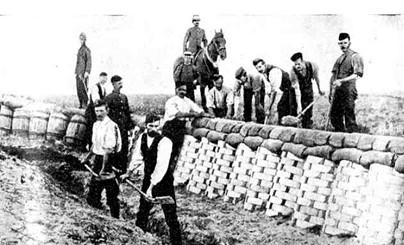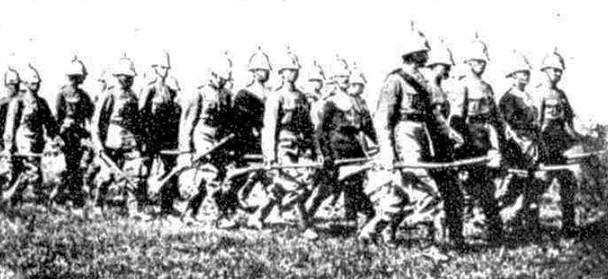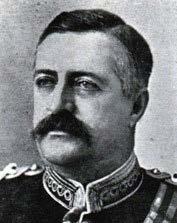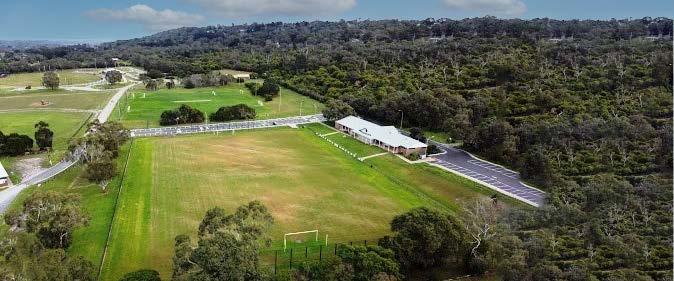
12 minute read
The Battle of Baxter's Flat
By Lance Hodgins
It was Friday 31 March 1899 and a dozen “specials” and five ordinary trains had been delivering troops all day to the little bush station beside the army camp at Langwarrin. By sunset, there were five battalions of militia infantry, as well as mounted rifles, rangers, engineers, ambulances and senior cadets – 3,008 soldiers in all –and their tents stretched to the horizon. Something was obviously afoot and rumours were rife.
An invasion force?
Finally, an announcement was made: AN INVASION FLEET HAS BEEN SIGHTED OFF WILSON’S PROMONTORY.
There were enemy ships of war accompanied by transports, all steaming westwards and likely heading for a landing point somewhere in Western Port with the intention of making a raid on Melbourne.
Military wisdom had anticipated such a move. The railway line to Stony Point had been conceived as a defence line during the various “Russian scares” and completed ten years earlier. Its first stop south of Frankston was at a site which became an annual training camp for Victoria’s defence forces. Langwarrin afforded a commanding view over Western Port from which “every hill and valley, every nook and corner, almost every bush and tree, to say nothing of rabbit holes, ought to be familiar to our defending field force.”

These were the days before Federation in 1901 and each colony was responsible for its own defence. Coastal garrison forts had been built but, with the expansion of rail networks, attention was turning towards more mobile units. Militia brigades were raised, partially paid, and obliged to train for several days each year. Country boys, often members of rifle clubs, could volunteer in the Rangers or, if they owned a horse and rode well, could don the iconic slouch hat and join the Victorian Mounted Rifles.
In 1899 the Victorian colonial force numbered about 6,000 and just over half of them were now in tents at Langwarrin awaiting further orders.
The invasion has begun!
As the troops poured into camp, the Commandant learned that the enemy had disembarked part of its force at Stony Point and had set up a screen of cavalry and infantry to cover further landings.
All Friday afternoon reconnoitring was carried out by patrols of Mounted Rifles who pushed forward towards Western Port to sight the enemy. Majors Braithwaite and Reay were in charge in the absence of Colonel Tom Price, the hero and idol of the Mounted Rifles, whose wife had passed away days before.
The officers determined that it was a sizeable landing party and there were probably more to come. The overall defence strategy would be to adopt passive tactics to hold the enemy and delay them from moving northwards. This would allow time for reinforcements to arrive; hopefully the new “Australian” naval squadron by sea and more infantry, artillery and supplies by land.
The ammunition train
Back at Langwarrin, the Camp was guarded by a ring of troops who were digging in and anticipating the engagement.
They were also anxiously awaiting the arrival of a train from Melbourne which would bring much-needed ammunition supplies.
Unfortunately, enemy secret agents in the city had learned of the train and passed on the details to mercenaries who, in turn, would have informed the enemy troops. The train was an obvious and vital target. To attack the train the enemy would have to intercept it somewhere between Frankston and Langwarrin.
A direct approach would take them up the Warrandyte Road where they would encounter the outposts and finally the camp itself.
On the other hand, they might divert westwards from Somerville and go across Baxter’s Flat to gain the high ground which stretched to the south west of the camp – the Mount Eliza ridge. From here they could swoop down on the train before it reached Langwarrin. Any defence would obviously have to cover both possibilities. Colonel Robertson was placed in charge and he began to set up his men in the traditional outpost fashion: sentries for observation, pickets to call back on supports close by and, behind all, a reserve for use whenever an attack might develop. His line stretched for over two miles from the Langwarrin Camp towards Mount Eliza.

Preparations for attack
Saturday morning broke warm and sultry.
A patrol of 100 mounted rifles set out from the Camp under Lieutenant-Colonel McLeish on a reconnaissance mission. They were only half way to Somerville when they sighted the enemy and immediately sent a message back to HQ that the invading force was a sizable one and approaching fast. McLeish was quite surprised, however, when his withering burst of fire met with little response and an immediate retreat. He wondered if this enemy approach might very well be a feint.
Back at camp, HQ received news of the sighting and was preparing an order for McLeish to hold the enemy for as long as possible when suddenly another scout galloped in. He carried news that the invaders were seen advancing in full force further to the west. This brought a revised order to McLeish: have your sentries fall back on their pickets and promptly take your troops to the right flank!
The officers at HQ were confident they could hold this right flank. It provided them with a distinct natural advantage: a ridge of up to 500 feet high running from the Langwarrin Camp in a south westerly direction to Mount Eliza. This afforded an excellent view over Baxter’s Flat to the south. Along its edge ran the Three Chain Road – today’s Moorooduc Highway – which was lined by hedges and wire fences.
The artillery and the front firing line of the defence was able to spread out along it for over two miles. First came Lieut-Col Reay with the volunteer Rangers and then four battalions of infantry under Lieut-Col Williams. Five companies of Senior Cadets under Lieut-Col Henry formed a crescent fringing the western edge of the hill, running almost up to Mount Eliza. On the plateau beyond and at the rear of this front line defence was the main body of infantry battalion, held along the Frankston-Hastings Road, with the Ballarat Rangers nearer the Camp to the east.
Colonel AE Otter had taken up a strong position half way along the ridge. From there he watched over the vast area of open fields lined with hedgerows, backed by a more distant zone of timber where he knew the enemy would find good cover.
Not only did Otter hold a commanding position but he also had a superior force: a very strong infantry backed up by the two Hastings siege guns which he positioned along the Mount Eliza ridge. The siege guns were 40 pounders firing six-inch shells and, although they were old artillery, they could still be fired over a mile with incredible accuracy by the highly trained men of the Hastings Battery.
Originally intended as stationary siege guns at Western Port, they were now capable of being drawn by teams of bullocks – an idea of their commanding officer, Captain Ham. This gave them a handy portability, and a new nickname; “the ham and beef battery”. Even so, their effectiveness in the field was still regarded as a calculated gamble and the authorities had taken some convincing to allow them into camp.
Bullocks had a reputation for being docile beasts but this didn’t prevent 16 of them escaping from camp overnight, which meant that Otter had to be content with having only two of the four 40-pounders at his disposal. The oxen proved to be far superior to horses and they were able to tow the heavy guns halfway up the heavily timbered Mount Eliza ridge and be positioned strategically to command the open country below - one half way along it and the other at the western end near the Moorooduc quarry.
With them in place, Otter knew that it would be extremely difficult for the enemy to forge its way over the flat lands and take the ridge.
Out in the open
The enemy was first spotted in the bush south west of Somerville, where they had bivouacked near the junction of Coolart and Bungower Roads before beginning their final march northwards. They had made good progress along Coolart Road. Now they had the final three miles across open paddocks and wire fences and they reached the cover of Eramosa Road and the edge of Baxter’s Flat in well under the hour.
The soldiers waiting on the ridge got their first sighting of the enemy. A small group of mounted infantry suddenly appeared out in the open, strung out in a frontal attack formation. Because of their small number, this was not visually threatening at first but everyone knew that behind them was a battalion in full swing.
A galloper was sent off to command HQ, informing them of what he had seen, and orders were returned that the enemy was to be kept in check as long as possible. As a consequence, Major Reay and his Mounted Rifles strategically fell back, whilst slowly contesting every position.
The open appearance of the enemy drew the fire of Colonel Otter’s 40 pounders along the ridge. They were still at some distance but he landed shrapnel in their midst which wiped out most of the enemy supports. The survivors were sent scurrying back to the tree cover and their main body of infantry. They must have realised that they had broken cover too soon.
Nonetheless, Otter was suspicious. It certainly looked like a sham – and Otter was convinced it was. He felt that coming out in the open like that was merely a way of diverting his attention from a more serious movement elsewhere. He had to make a quick decision. Would he need to concentrate on the right flank - or the left?
Once they were screened again by vegetation, the enemy moved westwards along Eramosa Road at an astounding pace. They were heading towards the right flank of defence – the senior cadets and one of the siege guns - which would meet the full force of their frontal attack. The second big gun had been angled to sweep the Three Chain Road along which it was expected the invaders would make their main attack. But it never came into use as intended.
The enemy’s speed of approach along Eramosa Road caught everyone by surprise and the flank of those defending the ridge defence was about to be breached. Led by their mounted cavalry, they charged up the ridge to meet the cadets, who had been belatedly reinforced by a company of Engineers. The young defenders found themselves right in the middle of the affray and unleashed a fusillade of shots as they desperately tried to hold their ground.
The enemy rushed past the flank, fighting every yard, and were soon amongst the heavy timber of the ridge. They had circumvented the heavy guns and turned to make a bold dash for one of them from behind, brazenly planning to yoke up the bullocks and drive off with them. The gun commander realised too late that he had been surrounded and he was in the laborious process of swinging his gun around when the enemy appeared out of the bush. All seemed lost.
At this stage, the whole defence line was witnessing the volleys being fired by the cadets from their forward position at the end of the ridge. Reports of the enemy’s rapid movement along Eramosa Road had been slow in reaching Colonel Otter and he realised too late that the ridge was at risk.

In a last ditch measure, Otter mobilised his final forces who were stationed along the plateau behind the ridge. Their appearance in great numbers and with superior firepower caught the enemy by surprise and immediately brought matters to a standstill. The enemy was forced to surrender.
The foe had been intercepted before reaching the railway. Had this not happened, the invading column might well have been in full march upon Melbourne within the hour, with a train-load of ammunition in their possession.
They all trudged back to Camp; the jubilant victors and their prisoners, with the ambulance carts bringing up the rear.
The debriefing
Back at Langwarrin, the officers were assembled and addressed by Commandant Sir Charles Holled Smith.
Smith praised the efficiency and discipline of all men in setting up the long line of defence around the camp and complimented the outpost system which operated from Camp. He was not happy with the slowness of the patrols in warning of the attack on the right flank, and blamed them for Colonel Otter’s inability to successfully block the taking of the ridge.
On the other hand, he heaped much praise on the outstanding job done by Lieut-Col Burston, who had commanded the one thousand troops who played the role of the “invaders”.


Burston had conducted an effective march to Baxter. Although he would have suffered casualties during his feint out into the open, he had then moved his men along the cover of Eramosa Road so quickly that they had climbed the ridge and successfully breached the right flank.
If “Cease Fire” of the exercise had been called a half hour earlier as originally planned, the judges would have been obliged to award the victory to the invaders.
The defenders pointed out that the enemy had, in fact, been ultimately confronted by a fresh battalion who had yet to fire a shot.
They argued that, although the “enemy” had already breached the flank and gained the ridge, they would have been easily prevented from reaching the railway line by such a powerful infantry force that had been kept in reserve.
Commandant Smith sat in the umpire’s chair and listened patiently to these arguments but he diplomatically refrained from saying whether the enemy attack would have reached the ammunition train or not.
And so, over a hundred years later, the question remains: who really did win the Battle of Baxter’s Flat?







